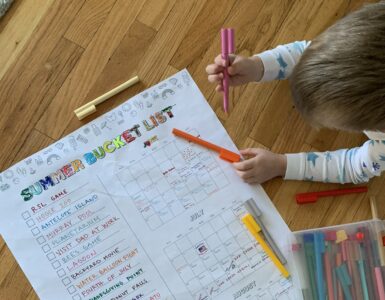Arm yourself with blue tape and a paint brush! Design your own chevron canvas print.
Art instructor Dani Henriksen gives step-by-step instructions on how to make this clean and simple modern statement art.
You will need:
Canvas
Pencil
Eraser
White professional acrylic paint (I recommend Golden brand paint)
Another professional quality acrylic paint color of your choice
Paintbrush (one large and one medium size)
Yardstick
Quilting Ruler: I bought the 24×6 inch Easy Rule II by Sharon Hultgren from Joanne’s
Blue painter’s tape
Step 1: Cover the entire canvas with a good quality white paint. I recommend using Golden brand. Do not be tempted to skip this step because the canvas is already white. The painting will be much prettier with a good coat of white paint. Since my canvas was so large (48″ x 24″), it went much faster to use a big brush. Allow the paint to dry overnight or speed it up with a hair dryer.
Step 2: I wanted 5 rows going across my canvas so I divided the height of the canvas by 5. The canvas is 24″ high so each row was just slightly less than 5 inches high. I drew 4 lines across the canvas with a yardstick to create the 5 rows.
Step 3: On the quilting ruler there are lines that show different angle degrees. I liked how the lines looked at a 45-degree angle. I randomly spaced out the lines in intervals of 1 inch, 1.5 inches, 2 inches, 3 inches and 4 inches across the canvas, and I pre-marked them on the canvas with the yardstick. Then I drew the lines at a 45-degree angle with the quilting ruler.
Step 4: Since the lines on the first row were drawn going down to the right, I drew the second row going down to the left. I continued drawing each row in opposite directions creating the chevron print. All lines were drawn at a 45-degree angle.
Step 5: The next step was to tape and paint. I chose to add some character by painting opposite colors on each row – except for the 2nd and 3rd row that I kept the same. Since I decided to do that I had to tape and paint rows 1, 3, and 5 first and allow them to dry before I could tape and paint rows 2 and 4. So I started by taping row 1. You will be putting tape wherever you want the canvas to be white. I put one long piece of tape all the way across the line that separates row 1 and 2. Then I put tape just outside my pencil lines so that the marks would be hidden underneath the gray paint. Those pencil marks are hard to hide and erase completely so it is important to carefully place your tape so the lines will be painted over. You might need to rip the painter’s tape in half to fit on the skinny spaces.
Step 6: Once all of the tape was in place on the first row I started painting. I used Golden brand gray paint. It is very important to purchase a professional thick and opaque color. It will look beautiful and it will not bleed under the tape. It will also cover the canvas really well in one coat as opposed to two or three coats with a cheap paint. Make sure the paint is added thickly enough that you can’t see any white. Be careful to make sure you are painting the right lines so that you are not messing up the design. Luckily I caught myself a couple times before making mistakes! The tape always bubbles a little bit after I paint it, even though I always make sure the tape is pressed down well before I paint. Do not wait long to pull off the tape. I recommend beginning to remove tape before you are half way across the row. For some reason the lines seem to come out cleaner when you remove the tape promptly.
Step 7: Once rows 1, 3 and 5 have dried for at least a few hours and feel dry to the touch, you can tape over them in preparation for painting rows 2 and 4. As I mentioned earlier I decided to paint the lines the same color in rows 2 and 3, which is just an option.
Step 8: Once all the rows have been painted it is time for some touch ups. Erase any pencil marks with an eraser then dab on a little white paint to cover up any marks you could not get off with the eraser. It is inevitable that there will be some imperfect lines where the paint bled. I re-taped and painted a handful of lines. Imperfections really stick out on geometric patterned painting like this.
Step 9: For the last step I chose to paint the 2-inch outside edge of the canvas gray. I taped straight lines going all the way around the edge of the canvas and then I painted all of the sides. Then the painting was finished!
Find out more easy art ideas from Dani go to:
And for kids, don’t miss Dani’s Intro to Art Class geared for 4 – 7 year olds. You get:
· Step-by-step instructions for 35 art projects
· A focus on 4 of the basic elements of art: colors, lines, shapes and textures
· Projects that allow for a lot of freedom of expression and experimentation with art materials
· Worksheets, compare and contrast activities and 4 art history lessons and projects that go along with those lessons
The class is a lot of fun and with such easy instructions ANYONE can teach art to their children. Some sample pictures from the instructional PDF:















Add comment